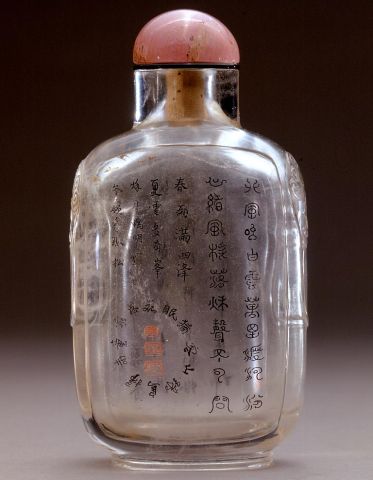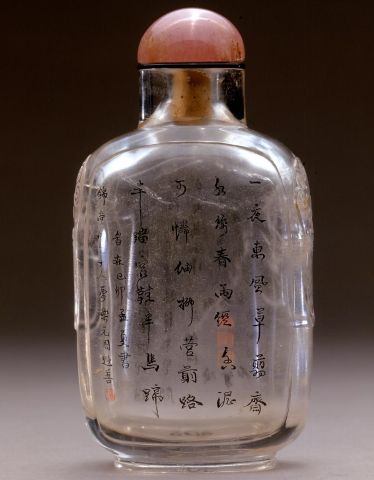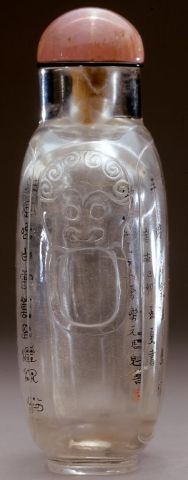


Bottle ID: 00902
ZHOU LEYUAN, FOUR DIFFERENT CALLIGRAPHIC SCRIPTS
Date: 1879
Height: 88 mm
Crystal, ink and watercolors, well-hollowed and of large rectangular form with sloping shoulders and mock mask ring handles, painted on the inside demonstrating the different calligraphic scripts. One side with a two-column inscription in zhuanshu (seal script) beside a four-column poem in xingshu (running script), above a circular xingshu inscription which encircles three seals of the artist Zhou, Le, and Yuan. The other side with a four-column inscription in caoshu (cursive script) and signed 'Inscribed in the first month of summer of the year yimao. Entrusted to the care of Kind Elder Brother, His Eminence Jintang, Leyuan, Zhou Kuishan' with one seal Yin.
Similar Examples:
Sotheby's, Hong Kong, November 16, 1989, lots 150 and 160, The Kaynes-Klitz Collection, Part I.
Provenance:
Asian Art Studio
Sotheby's, Hong Kong, October 30, 2000, lot 539
Guo'an Collection, Inventory no. 346
Hugh Moss Ltd., Hong Kong, 1981
Exhibited:
Annual Convention ICSBS Toronto, October 2007
Published:
JICSBS, Autumn 2008, p. 23, fig. 12 and p. 25, figs. 16, 16a and 16b.
JICSBS, Winter 2007, p. 19, fig. 8
The inscriptions read in order:
In zhuanshu:
'As the north wind blows white clouds along,
My journey, infinitely long, crosses the Yellow and the Fen,
Here my mood suddenly withers and falls,
I can no longer bear to hear the sounds of autumn'.
This poem is by the Tang poet, Su Ting (620-727) and is entitled Fenshang - On the Fen River, Startled by the Sudden Onset of Autumn. The region between the Yellow and the Fen rivers corresponds to the southeastern part of modern day Shanxi Province.
In xingshu:
'Spring waters fill lakes and marshes all around,
Summer clouds create even more marvelous peaks,
Autumn moon spreads its brilliant light,
Winter mountains enhance the beauty of solitary pines'.
This poem entitled Sishi - The Four Seasons - appears in the collected works of Tao Qian (Tao Yuanming 365-427). However, it has been acknowledged for centuries that this poem has been taken from the middle of a longer poem by the early great painter and talented poet, Gu Kaizhi (341-402).
The circular inscription:
'Blossoms fall but my houseboy is yet to sweep them up,
Birds call but this mountain recluse still sleeps on'.
This inscription is a couplet from a poem by Wang Wei (699-759) entitled Tianyuan le - The Joys of Field and Garden.
In caoshu:
'East wind all night long left undergrowth trimmed flat
As a silk-like rain wet the fragrant mud.
So delicate they melt one's soul - those willows on the road before the garrison,
With its imprints made half by bound feet in tiny shoes and half by horse's hooves'.
This is from a poem by Liang Shaoren (born 1792) entitled "Miscellaneous Jottings From Two Kinds of Autumn Rain Studio". It is a very unusual poem to be used by any of the Middle School artists, as it was not very popular and had only recently been published in 1837, just over forty years before this bottle was painted by Zhou Leyuan. This raises the question of whether Zhou was aware of the poem and chose to use it for this bottle, or that the person who commissioned this bottle, Jintang, also requested that Zhou use this poem.
This is an extraordinary bottle by Zhou Leyuan in many ways, and not the least, for having been penned in the first recorded year of his painting. In some ways it follows the literati concept stemming from the works of both Gan Xuanwen and, more emphatically, the northern painter, Yiru Jushi, where both sides of the bottle are used to display the calligraphic talents of the painter. Yet Zhou was not a scholar, he was a professional, commercial painter and the apparent founder of the Beijing School. He must, however, have aspired to the literati class as many of his works show knowledge of poems and writings from earlier centuries.
This bottle also presents a conundrum - how is it possible that this was one of the first examples of Zhou's work? Both in terms of its conception and high quality, it is hard to visualize this as the beginning of his vocation and the establishment of a new school of painting. The calligraphy is extremely skilled although it is different in style from his later work. The crystal bottle is clear rather than typically 'frosted'. Zhou has signed the bottle using his personal name, Zhou Kuishan, a practice which he quickly dropped. If Zhou was, as hearsay suggests, a silk lantern painter prior to turning to painting inside snuff bottles, he must have learned both painting and calligraphy as a young man.
The Crane bottle cannot, however, have been Zhou's very first or even second bottle. He could not have awoken one morning with the inspiration, the artistic know-how and the physical tools (the bamboo pen) and simply painted this bottle. Was Zhou a perfectionist? How many bottles were discarded before this one was acceptable to him? How many of the undated bottles documented in collections could possibly have come before this one? And the most important question of all raised by this bottle - who was Zhou's teacher? Even the artist recognized as the founder or first master of this School had a teacher; lineage was an important aspect which was usually passed down through the family, and by his students. Despite the reasonably large number of his extant works, the lack of knowledge concerning Zhou Leyuan hinders our understanding of the whole development of inside painted bottles.
< Back to full list
 English
English 中文
中文